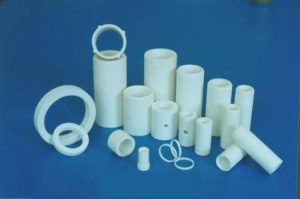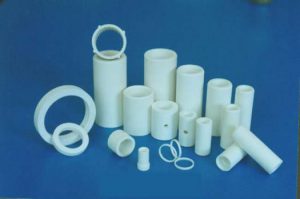Zirconia ceramics are characterized by unique physical and chemical properties such as high hardness, low thermal conductivity, high melting point, resistance to high temperature and corrosion, chemical inertia and amphoteric properties. As a special ceramic material, zirconia has a broad application prospect in electronics, aerospace, aviation, and nuclear industries.
At present, the toughening methods of ceramics mainly include phase transformation toughening, particle toughening, fiber toughening, self-toughening, diffusion toughening, co-toughening and nano toughening.

- Phase transformation toughening
The toughening of the phase transition refers to a phase transition of t-ZrO2 of the metastable quadrilateral phase under the stress field at the crack tip, then the compressive stress is formed on the crack, which hinders the crack growth and plays a role of toughening.
Besides, external conditions (such as laser shock, fatigue fracture toughness, low temperature, grain size and content, critical transformation energy, etc.) have great influence on the toughening of zirconia ceramics. If the stress and volume produced by the phase transition are large, the product is prone to fracture. Therefore, the influence of external factors on the toughening of zirconia ceramics should be avoided in the production process.
- Particles toughening
Particle toughening refers to adding ZrO2 ceramic powder as a toughening agent. Although the effect is not as good as whisker and fiber, there is still a certain toughening effect if the type, size, content and matrix materials are selected properly. The advantages of particle toughening are simple and feasible, and the toughening will bring about the improvement of high-temperature strength and high-temperature creep property. The toughening mechanism of particle toughening mainly includes grain refinement and crack turning to the bifurcation.
- Fibre toughening
The toughening principle of fiber and whisker is that the closed stress is applied to the crack surface due to the deformation of crystal close to the crack tip, the external stress of the crack tip is offset, and the passivating crack growth is achieved, so as to play a toughening role. In addition, when the crack grows, the pulling out of the column crystal also overcomes the friction force, which also plays a role in toughening.
- The self-toughening
Due to the existence of columnar crystals, the fracture process of zirconia ceramics can cause the crack to deflect, change and increase the crack growth path, thus passivating the crack to increase the crack growth resistance, thus achieving the purpose of toughening.
- Dispersion toughening
Diffusion toughening mainly refers to the toughening of tetragonal ZrO2 particles to ceramic matrix. Besides the phase change toughening mechanism, there is also the diffusion toughening mechanism of the second phase particle. Before the crack propagation, the internal residual strain energy of the ceramics must be overcome, so as to achieve the purpose of toughening.
- Microcrack toughening
Microcrack toughening refers to adding ductile materials to the stress tip of the crack to generate microcracks to disperse the stress, reduce the force of the crack forward, and thus increase the toughness of the material. When phase transition occurs, residual strain energy effects and microcracks often occur. Therefore, the effect of phase transition and toughening is remarkable.
- Composite toughening
Composite toughening refers to the application of several toughening mechanisms in the actual toughening process of ZrO2 ceramics, so as to improve the toughening effect of ZrO2 ceramics. In the practical application process, the specific toughening mechanism is selected according to the different properties of zirconia ceramic materials to be prepared.
Please visit http://www.samaterials.com for more information.
